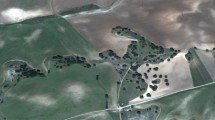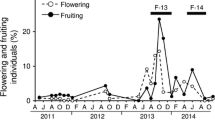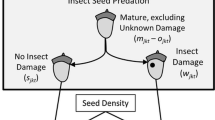Abstract
Mast-seeding behaviour was monitored in 18 populations of eight species of the African cycad genus Encephalartos between 1988 and 1991. The coefficient of variation (V) in annual cone production for each population ranged between 88 and 200, indicating large fluctuations in reproductive effort between years. Data were collected to determine whether mast-seeding reduced levels of predispersal seed predation by satiating seed predators in mast years and whether it resulted in a reproductive advantage over plants which reproduced more frequently. Masting intensity was greatest in those populations in which individual plants suffered the highest levels of predispersal seed predation in years when only a few plants produced seeds. The principal seed predators were two congeneric weevil species, Antliarhinus zamiae and A. signatus, which develop exclusively on cycad seeds. The lowest intensity of mast-seeding was recorded for cycad populations with low levels of seed predation and in which A. zamiae and A. signatus occurred only in low numbers or were entirely absent. Larger seed crops appeared to result in lower levels of seed predation by A. zamiae and A. signatus in four populations of E. altensteinii, and differences in seed crop size accounted for 48–66% of variation in levels of seed predation in populations of five cycad species. In one population of E. altensteinii, lower levels of seed predation in plants reproducing periodically resulted in a reproductive advantage over plants reproducing more frequently. These results are consistent with the predator satiation hypothesis. However, in most cycad populations, numbers of seed predators did not appear to decrease significantly after a period of 2–8 years between reproductive episodes and, in two of three populations examined, periodic reproduction did not increase the number of seeds surviving to dispersal over a 4-year period. These results are interpreted to mean that periodic reproduction has not evolved in response to selection imposed by seed predators, but that selection may favour those plants which experience lower levels of seed predation by coning in synchrony with the majority of plants in the population.
Similar content being viewed by others
References
Acocks JPH (1988) Veld types of South Africa, 3rd edn. Mem Bot Survey S Afr 57: 1–146
Augspurger CK (1981) Reproductive synchrony of a tropical shrub: experimental studies on the effects of pollinators and seed predators on Hybanthus prunifolius (Violaceae). Ecology 62:775–789
Ballardie RT, Whelan RJ (1986) Masting, seed dispersal and seed predation in the cycad Macrozamia communis. Oecologia 70:100–105
Beattie AJ, Breedlove DE, Ehrlich PR (1973) The ecology of the pollinators and predators of Frasera speciosa. Ecology 54:81–91
Caughley G, Lawton JH (1981) Plant-herbivore systems. In: RM May (ed) Theoretical Ecology, 2nd edn. Blackwell, Oxford
Cippollini ML, Stiles EW (1991) Seed predation by the bean weevil Acanthoscelides obtectus on Phaseolus species: consequences for seed size, early growth and reproduction. Oikos 60:205–214
Clark DA, Clark DB (1987) Temporal and environmental patterns of reproduction in Zamia skinneri, a tropical rainforest cycad. J Ecol 75:135–149
De Steven D (1983) Reproductive consequences of insect seed predation in Hamamelis virginiana. Ecology 64:89–98
Donaldson JS (1991) Adaptation to the host-plant, and the evolution of host specialization, in ‘cycad weevils’ (Coleoptera: Brentidae). Unpublished PhD Thesis, University of Cape Town, South Africa
Donaldson JS (1992) Adaptation for oviposition into concealed cycad ovules in the cycad weevils, Antliarhinus zamiae and A. signatus (Coleoptera: Curculionoidea). Biol J Linn Soc 47:23–35
Donaldson JS (in press) Insect predation of ovules in the South African species of Encephalartos (Cycadales: Zamiaceae). Proceedings of the Second International Congress on Cycad Biology, Townesville, Australia
Emlen ST, Demong NJ (1975) Adaptive significance of synchronised breeding in a colonial bird: a new hypothesis. Science 188:1029–1031
Goode D (1989) Cycads of Africa. Struik Winchester, Cape Town
Grobbelaar N (1990) Masting by cycads. Encephalartos: 21–22
Janzen DH (1971) Seed predation by animals. Annu Rev Ecol Syst 2:465–492
Janzen DH (1975) Behaviour of Hymenaea courbaril when its predispersal seed predator is absent. Science: 145–147
Janzen DH (1976) Why bamboos take so long to flower. Annu Rev Ecol Syst 7:347–391
Newell SJ (1983) Reproduction in a natural population of cycads (Zamia pumila L.) in Puerto Rico. Bull Torrey Bot Club 110:464–473
O'Dowd DJ, gill AM (1984) Predator satiation and site alteration following fire: mass reproduction of alpine ash (Eucalyptus delegatensis) in southeastern Australia. Ecology 65:1052–1066
Ornduff R (1987) Sex ratios and coning frequency of the cycad Zamia pumila L. (Zamiaceae) in the Dominican Republic. Biotropica 19:361–364
Ornduff R (1989) Size distribution and coning behaviour of the Australian cycad Lepidozamia peroffskyana. Aust J Ecol 14:241–245
Ornduff R (1990) Geographic variation in reproductive behaviour and size structure of the Australian cycad Macrozamia communis (Zamiaceae). Am J Bot 77:92–99
Ornduff R (1991) Size classes, reproductive behaviour, and insect associates of Cycas media (Cycadaceae) in Australia. Bot Gaz 152:203–207
Silvertown JW (1980) The evolutionary ecology of mast seeding in trees. Biol J Linn Soc 14:235–250
Smith CC, Hamrick JL, Kramer CL (1990) The advantage of mast years for wind pollination. Am Nat 136:154–166
Solbreck C, Sillén-Tullberg B (1986) Seed production and seed predation in a patchy and time-varying environment. Dynamics of a milkweed-tephritid fly system. Oecologia 71:51–58
Solbreck C, Sillén-Tullberg B (1990) Population dynamics of a seed feeding bug, Lygaeus equestris. 1. Habitat patch structure and spatial dynamics. Oikos 58:199–209
Werner PA, Caswell H (1977) Population growth rates and age versus stage-distribution models for teasel (Dipsacus sylvestris Huds.). Ecology 58:1103–1111
Wright SJ (1990) Cumulative satiation of a seed predator over the fruiting season of its host. Oikos 58:272–276
Zar JH (1984) Biostatistical analysis. 2nd edn. Prentice Hall, Englewood Cliffs, NJ
Author information
Authors and Affiliations
Rights and permissions
About this article
Cite this article
Donaldson, J.S. Mast-seeding in the cycad genus Encephalartos: a test of the predator satiation hypothesis. Oecologia 94, 262–271 (1993). https://doi.org/10.1007/BF00341326
Received:
Accepted:
Issue Date:
DOI: https://doi.org/10.1007/BF00341326




